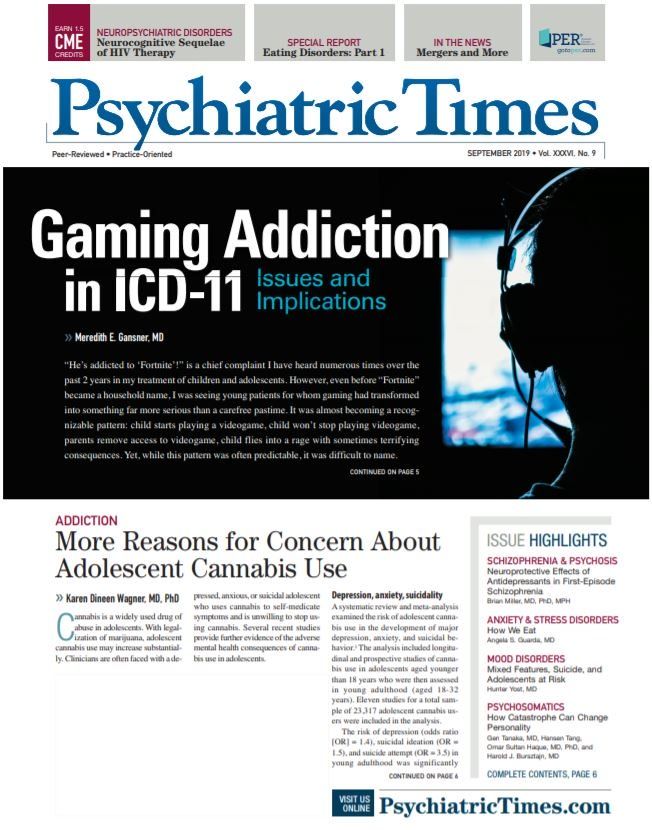Publication
Article
Psychiatric Times
How Anxiety and Habits Contribute to Anorexia Nervosa
Author(s):
Anorexia nervosa (AN) is a severe and debilitating illness with one of the highest mortality rates of any psychiatric disorder. The illness course is often long, recovery is slow, and the rates of full recovery are low.
©AfricaStudio/Shutterstock

Anorexia nervosa (AN) is a severe and debilitating illness with one of the highest mortality rates of any psychiatric disorder. Epidemiologic studies show that AN affects males and females, children and adults, and individuals of all races and ethnicities, although some data suggest that it is most prevalent among white females.1 AN is characterized by severe food restriction leading to an unhealthily low body weight, as well as body image distortion and intense fear of weight gain.
The illness course is often long, recovery is slow, and the rates of full recovery are low. Currently, treatments that emphasize behavioral change (with monitoring of eating and weight) are the most useful, with no one modality emerging as the treatment of choice. Medications have been generally disappointing, and none to date have been approved by the FDA for treatment of AN. A recent, large randomized controlled trial suggests a potential benefit of olanzapine for outpatients with AN.2
Eating behavior in AN is, in many ways, impressively stereotyped. When food intake has been carefully measured through observation or laboratory studies, individuals with AN have been shown to limit caloric intake, and to specifically limit intake from fat. Dietary restriction occurs during acute illness and does not normalize with weight restoration.3 Food restriction can begin for a wide range of reasons beyond intent to lose weight. Some individuals, for example may experience weight loss due to a medical illness, or after joining a new sports team.
Once restrictive eating behaviors are established, they become remarkably similar across individuals with AN: low-calorie diets with limited food variety and in particular, avoidance of fat. Eating is also associated with high anxiety and often accompanied by ritualized behaviors. Eating behavior studies underscore that the salient and central problem of AN is maladaptive eating.
Specialized behavioral inpatient units are highly successful in helping individuals with AN get renourished.4 Unfortunately, relapse rates post-hospitalization are high. One challenge in treating AN is that maladaptive eating patterns persist even after acute treatment and have been shown to predict worse outcomes in the longer term.5 Individuals who were eating a wider variety of foods, and consuming food with higher energy density toward the end of their inpatient stay were more likely to be doing well one year after hospital discharge. Understanding how these patterns form and why they persist can provide insights into how to better treat this disorder.
Anxiety and AN
Links between anxiety disorders and AN have long been noted. Comorbid presentations are common, especially with OCD or social phobia.6 It is also common that an individual with AN had an antecedent anxiety disorder in childhood. Anxious personality traits including neuroticism, perfectionism, and harm avoidance are common among patients with AN.7 Underweight patients with AN report a range of anxious symptoms and score high on measures of anxiety. Significant amelioration of anxiety symptoms occurs with treatment, although weight-restored individuals endorse significantly more anxiety symptoms than healthy controls.
Mealtime anxiety, specifically, is very common and contributes to limited intake, which may be important in the persistence of illness. Neuroimaging studies have used fMRI to measure activity in neural circuits while patients with AN are passively viewing disorder-related stimuli (eg, food, bodies). These studies have shown activation of fear-related circuits that differs from healthy individuals.8 While these studies may support a role for fear circuitry in the persistence of AN, links with actual maladaptive behavior are not commonly tested.
High anxiety and the use of avoidance behaviors to manage anxiety lead to the proposal that eating-related anxiety is the cause of the persistence of illness, and it may be a useful treatment target.9 In the anxiety-centered approach to AN, avoidance behaviors and rituals around food are seen as akin to phobic behaviors, and rituals around eating are seen as akin to compulsions of OCD.
Habit and AN
The entrenched persistence of restrictive eating in AN has also led to consideration of the possibility that these behaviors have become habitual.10 Habits are defined as behaviors that are learned-not innate-and through repetition have become nearly automatic and highly resistant to change. Consistent with this model, restrictive eating is a learned behavior, and it is often described by patients as having been rewarding initially.
The rewards can be quite individualized: one person may have received compliments for weight loss that were rewarding, while another may find intrinsic reinforcement from a feeling of self-control. These experiences likely activate reward pathways in the brain (ie, ventral striatum, orbitofrontal cortex), which in turn support the continuation of food restriction. As restrictive eating continues, the goal-directed behaviors that were once reinforcing become more automatic. As behavior is repeated and entrained, it can become more tightly linked to the cues (external and internal) that stimulated the behavior and less linked to the previously rewarding outcome.
The process of habit formation is accompanied by a shift in neural correlates.11 Neural pathways implicated in habits include the dorsal striatum and the dorsolateral prefrontal cortex (dlPFC). Disturbances in the dlPFC and dorsal striatum are thought to underlie other psychiatric disorders characterized by repetitive, maladaptive behaviors, such as OCD and substance abuse.
For patients with AN, cues may include the expectation of food, changes in mood, or life stressors. In this habit-centered framework, the ritualistic, compulsive behaviors of the illness, such as cutting food into small pieces or body checking, have become linked with cues and are relatively independent of the outcome-and thereby more automatic. For example, body checking may have once served as a rewarding behavior for a patient who was monitoring her weight loss but has since become a nearly reflexive action occurring any time she eats.
In a first test of the role of habit in maladaptive eating behavior in AN, participants were asked to make choices about what food to have as a snack during fMRI scanning. Among individuals with AN, choice was associated with greater activity in the dorsal striatum compared with healthy controls.12 Activity in the dorsal striatum was correlated (ie, functionally connected) with a region in the dlPFC. These findings suggest that dorsal frontostriatal circuitry underlies maladaptive restrictive food choice in AN and provide support for the habit model.
Stress, habit, and anxiety in AN
Broadly speaking, stress may link anxiety and habit into one integrated model of AN. Stress induces alterations in various neurotransmitter systems (eg, dopamine, glutamate) and can facilitate habitual action patterns. Acutely ill patients with AN have been found to have chronically elevated cortisol levels that normalize with weight restoration.13 Chronic stress further strengthens habitual responses as dendritic morphology in brain areas such as the nucleus accumbens and dorsolateral striatum is altered.14
Moreover, starvation alters multiple hormonal systems that may influence learning and habit formation through neuromodulation. Combined, stress and starvation may have epigenetic effects that influence risk for AN or maintain the disorder.15
Importance of behavior-based treatments
Successful treatment for AN may require both interruption of maladaptive habits (ie, excessive exercise and dietary restraint) combined with reduction in anxiety and avoidance behavior. These approaches differ in their mechanisms, but both emphasize a focus on behavior. Behavior therapy components are in many ways well established as useful in the treatment of eating disorders.
Family-based therapy (FBT), the first-line treatment for adolescents with AN, as well as specialized behavioral inpatient or day treatment programs for adolescents and adults, focus on behavioral elements.4 Out- patient psychotherapies such as cognitive behavioral and dialectic behavioral therapy for AN utilize behavior therapy as well. Yet, treatment outcomes remain disappointing. Habit and anxiety focused approaches may suggest new behavioral tools to improve treatment of AN.
Exposure therapy, the gold standard treatment for anxiety disorders, has been adapted for treatment of AN. Treatment emphasizes confronting-not avoiding-the feared stimulus and having in-session experience of disconfirming the feared outcome. These approaches have focused on eating-related stimuli or on body image (via mirror-exposure). Other potentially useful techniques may include increasing attention to extinguishing fears of risk foods in meal-based settings and body image therapy following weight restoration (as opposed to only during weight gain) as well as use of virtual reality environments. Most studies are small pilot approaches, but results have generally been encouraging.16
If maladaptive behaviors are habitual, however, then treatment needs to specifically address the cues that lead to the behavior (not the feared outcomes). In one pilot study, patients received an adjunctive intervention developed from habit-reversal therapy. The intervention identified cues for maladaptive behavior and focused on development of new actions in response to cues, as well as suppression of maladaptive routines. Compared with those who received supportive psychotherapy, the novel intervention was associated with decreased habit strength and decreased eating disorder symptoms.17
As neural mechanisms of maladaptive behavior are identified, new pathways for therapeutics emerge. Neuromodulation with transcranial magnetic stimulation (TMS) may be used to directly target pathways implicated in fear learning and/or in habit formation. TMS of the ventromedial prefrontal cortex has shown promise in fear extinction and is beginning to be tested in AN.18,19
AN is a severe psychiatric disorder and patterns of restrictive eating have proven to be very entrenched, contributing to high rates of persistent illness. Current data suggest that these maladaptive eating patterns are related both to high anxiety and to habits. Neural mechanisms underlying this illness suggest that brain circuits related to fear and to reward learning may relate to illness. Behavioral interventions aimed at habit and anxiety reduction have shown promise, and their success provides further support toward future research in this area.
Disclosures:
Ms Rufin is a graduate student in public health, and Dr Steinglass is Associate Professor of Clinical Psychiatry, Department of Psychiatry, Columbia University Irving Medical Center/New York State Psychiatric Institute, New York, NY. Ms Rufin reports no conflicts of interest; Dr Steinglass reports that she has financial interests in UpToDate, the Klarman Family Foundation, the Hilda and Preston Davis Foundation, the National Eating Disorders Association, and the NIMH.
References:
1. Udo T, Grilo CM. Prevalence and Correlates of DSM-5 defined eating disorders in a nationally representative sample of US adults. Biol Psychiatry. 2018;84:345-354.
2. Attia E, Steinglass JE, Walsh BT, et al. Olanzapine versus placebo in adult outpatients with anorexia nervosa: a randomized clinical trial. Am J Psychiatry. 2019;176:449-456.
3. Walsh BT. The importance of eating behavior in eating disorders. Physiol Behav. 2011;104:525-529.
4. Attia E, Walsh BT. Behavioral management for anorexia nervosa. N Engl J Med. 2009;360:500-506.
5. Schebendach J, Mayer LE, Devlin MJ, et al. Dietary energy density and diet variety as risk factors for relapse in anorexia nervosa: a replication. Int J Eat Disord. 2012;45:79-84.
6. Kaye WH, Bulik CM, Thornton L, et al. Comorbidity of anxiety disorders with anorexia and bulimia nervosa. Am J Psychiatry. 2004;161:2215-2221.
7. Atiye M, Miettunen J, Raevuori-Helkamaa A. A meta-analysis of temperament in eating disorders. Eur Eat Disord Rev. 2015;23:89-99.
8. Fuglset TS, Landro NI, Reas DL, Ro O. Functional brain alterations in anorexia nervosa: a scoping review. J Eat Disord. 2016;4:32.
9. Steinglass JE, Sysko R, Glasofer D, et al. Rationale for the application of exposure and response prevention to the treatment of anorexia nervosa. Int J Eat Disord. 2011;44:134-141.
10. Walsh BT. The enigmatic persistence of anorexia nervosa. Am J Psychiatry. 2013;170:477-484.
11. Graybiel AM. Habits, rituals, and the evaluative brain. Ann Rev Neurosci. 2008;31:359-387.
12. Foerde K, Steinglass JE, Shohamy D, Walsh BT. Neural mechanisms supporting maladaptive food choices in anorexia nervosa. Nat Neurosci. 2015;18:1571-1573.
13. Monteleone P, Scognamiglio P, Monteleone AM, et al. Abnormal diurnal patterns of salivary alpha-amylase and cortisol secretion in acute patients with anorexia nervosa. World J Biol Psychiatry. 2011;12:455-461.
14. Taylor SB, Anglin JM, Paode PR, et al. Chronic stress may facilitate the recruitment of habit- and addiction-related neurocircuitries through neuronal restructuring of the striatum. Neuroscience. 2014;280:231-242.
15. Klengel T, Mehta D, Anacker C, et al. Allele-specific FKBP5 DNA demethylation mediates gene-childhood trauma interactions. Nat Neurosci. 2013;16:33-41.
16. Steinglass JE, Albano AM, Simpson HB, et al. Confronting fear using exposure and response prevention for anorexia nervosa: a randomized controlled pilot study. Int J Eat Disord. 2014;47:174-180.
17. Steinglass JE, Glasofer DR, Walsh E, et al. Targeting habits in anorexia nervosa: a proof-of-concept randomized trial. Psychol Med. 2018:1-8.
18. Guhn A, Dresler T, Andreatta M, et al. Medial prefrontal cortex stimulation modulates the processing of conditioned fear. Front Behav Neurosci. 2014;8:44.
19. Dalton B, Bartholdy S, McClelland J, et al. Randomised controlled feasibility trial of real versus sham repetitive transcranial magnetic stimulation treatment in adults with severe and enduring anorexia nervosa: the TIARA study. BMJ Open. 2018;8:e021531.
Newsletter
Receive trusted psychiatric news, expert analysis, and clinical insights — subscribe today to support your practice and your patients.






